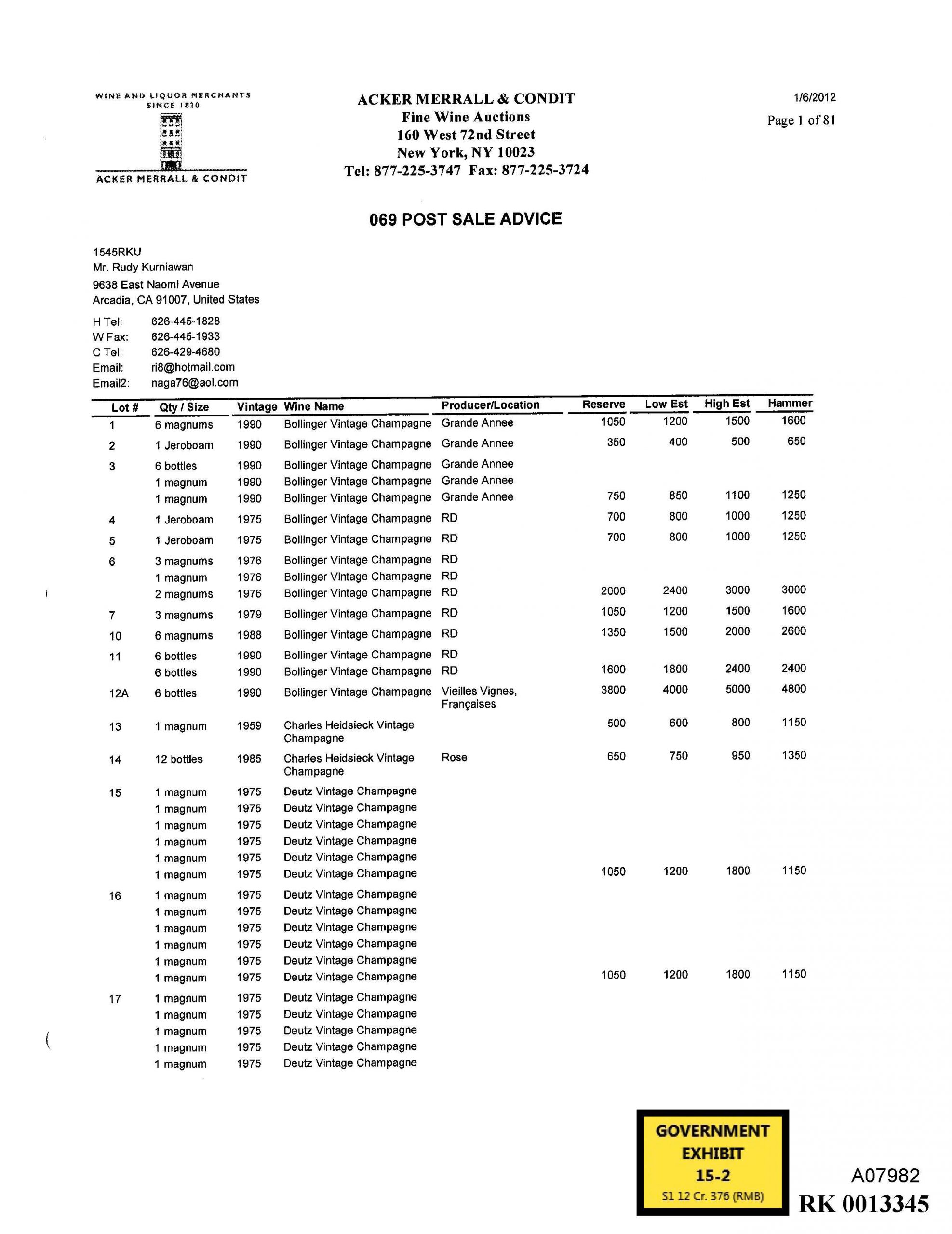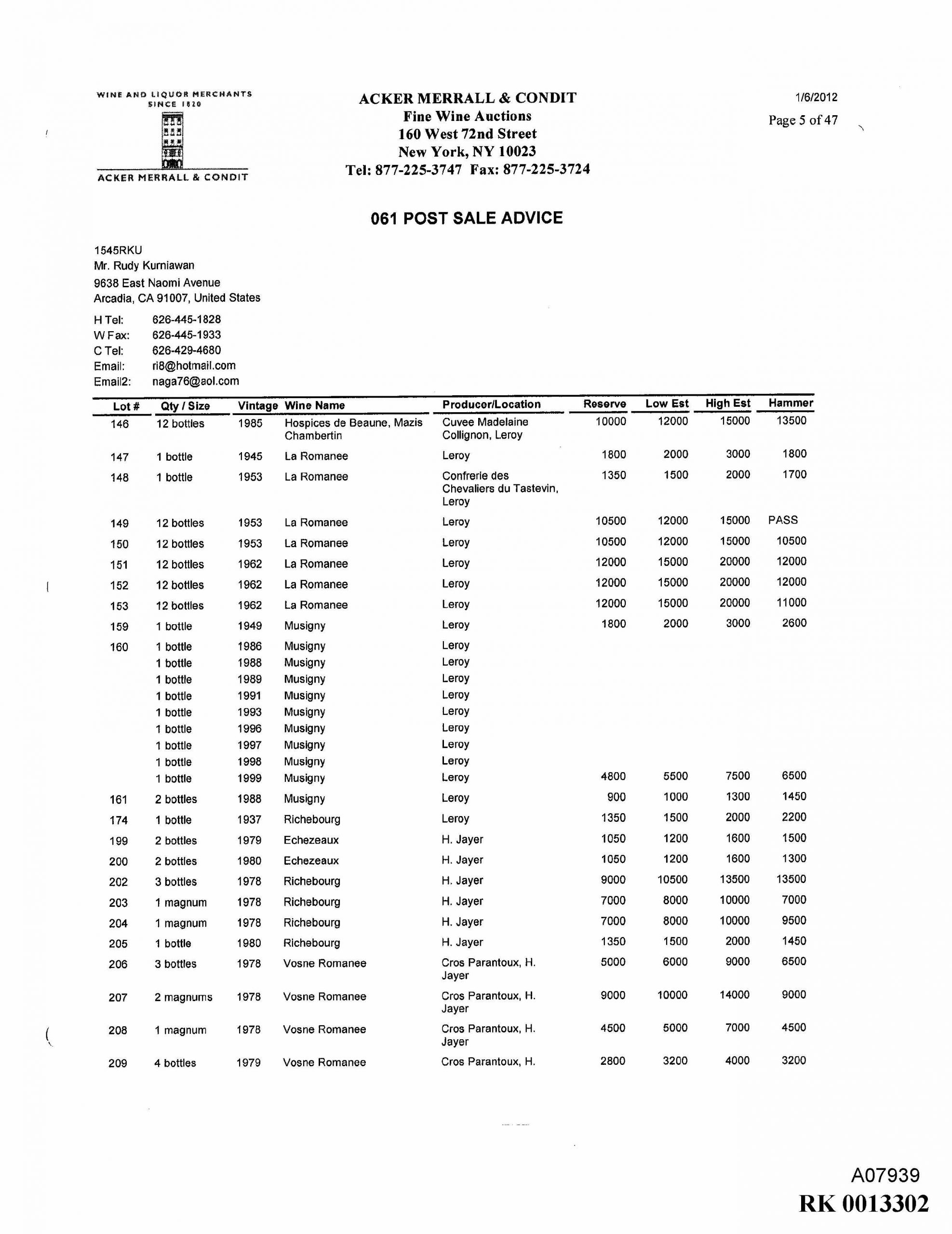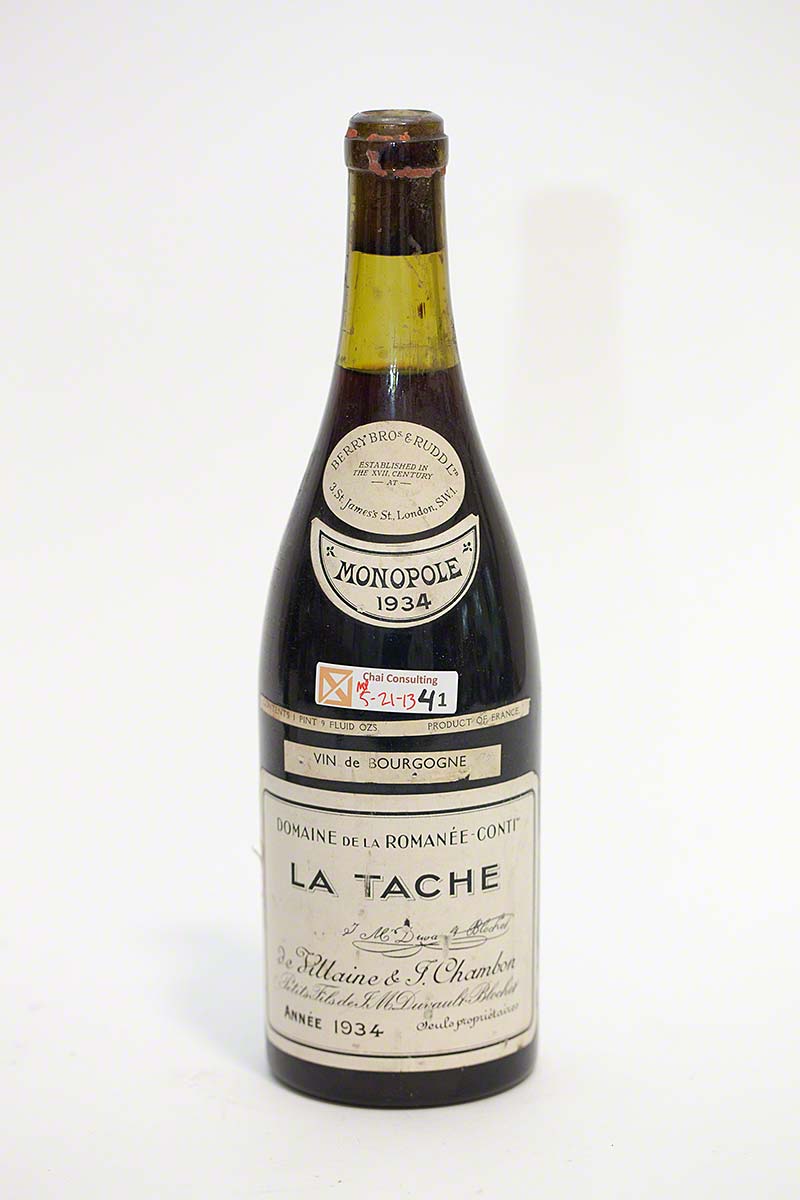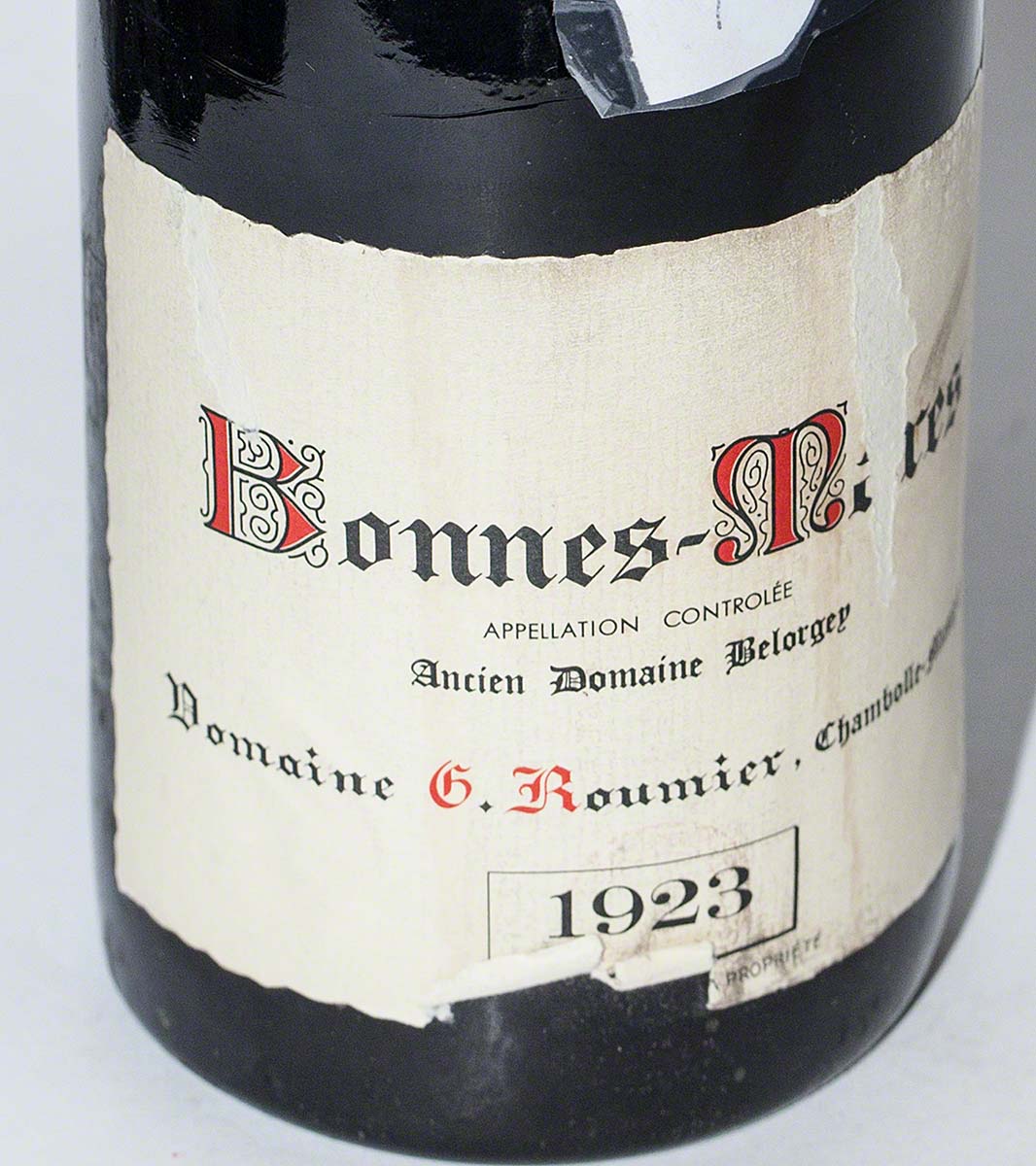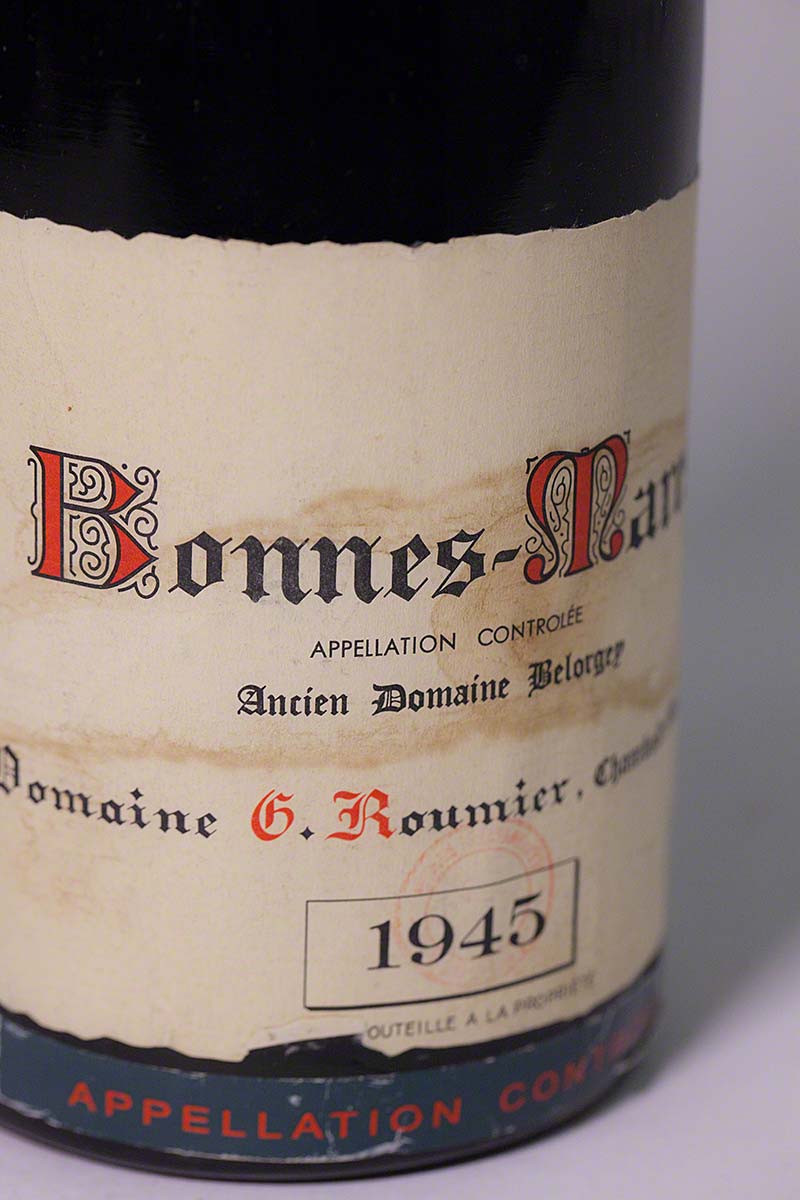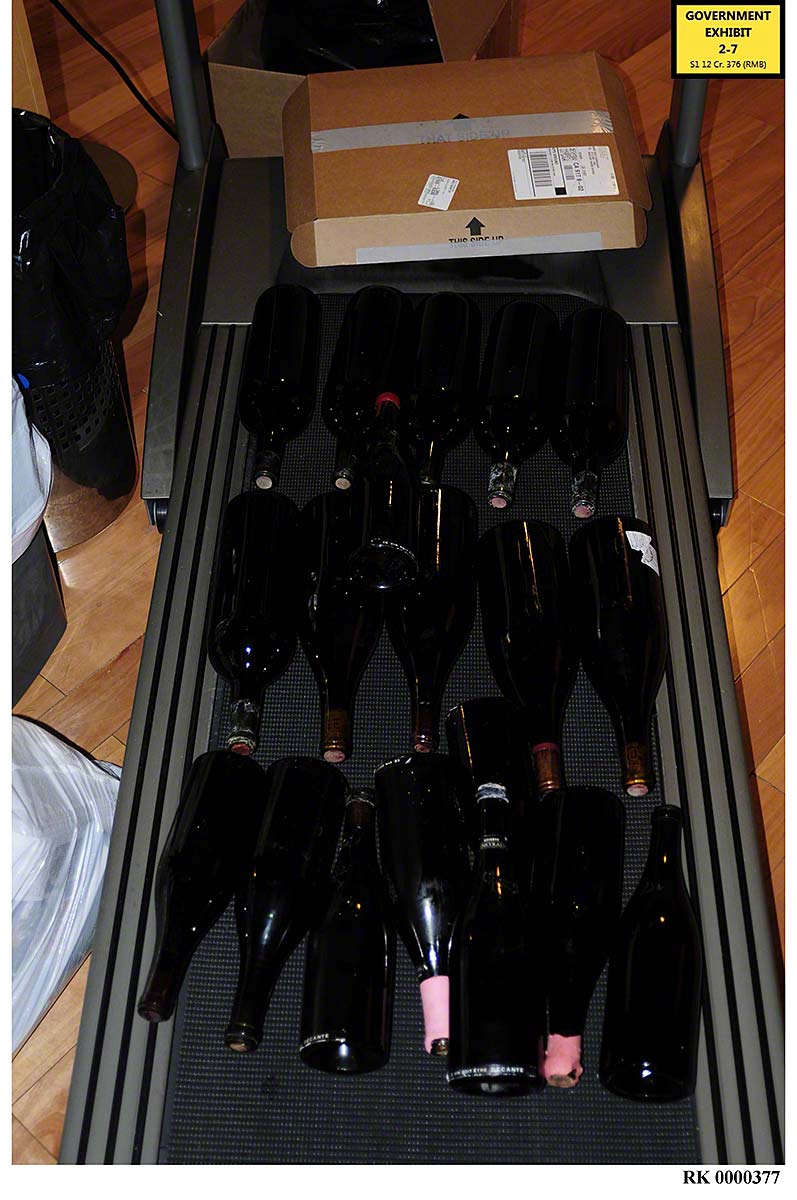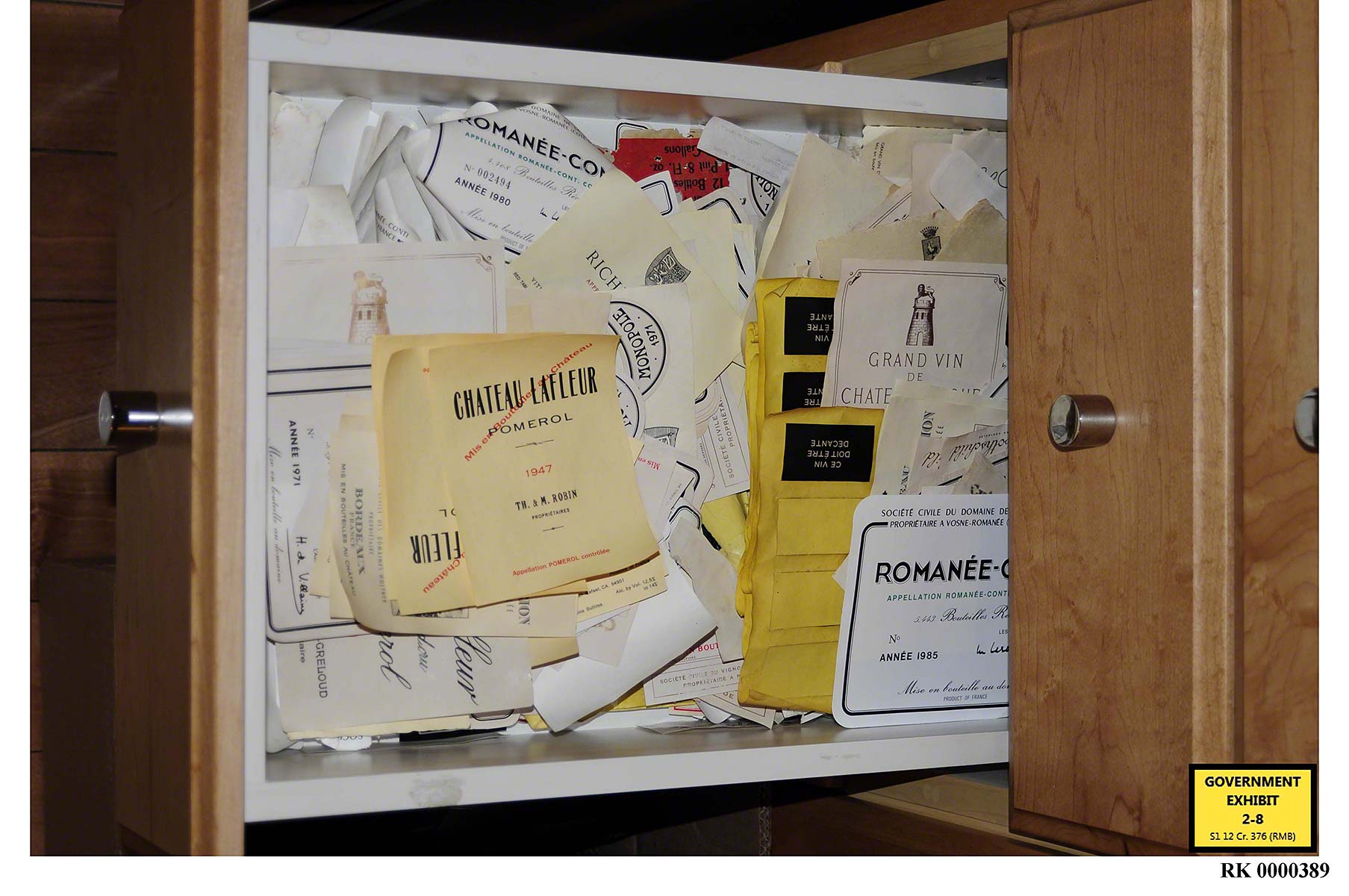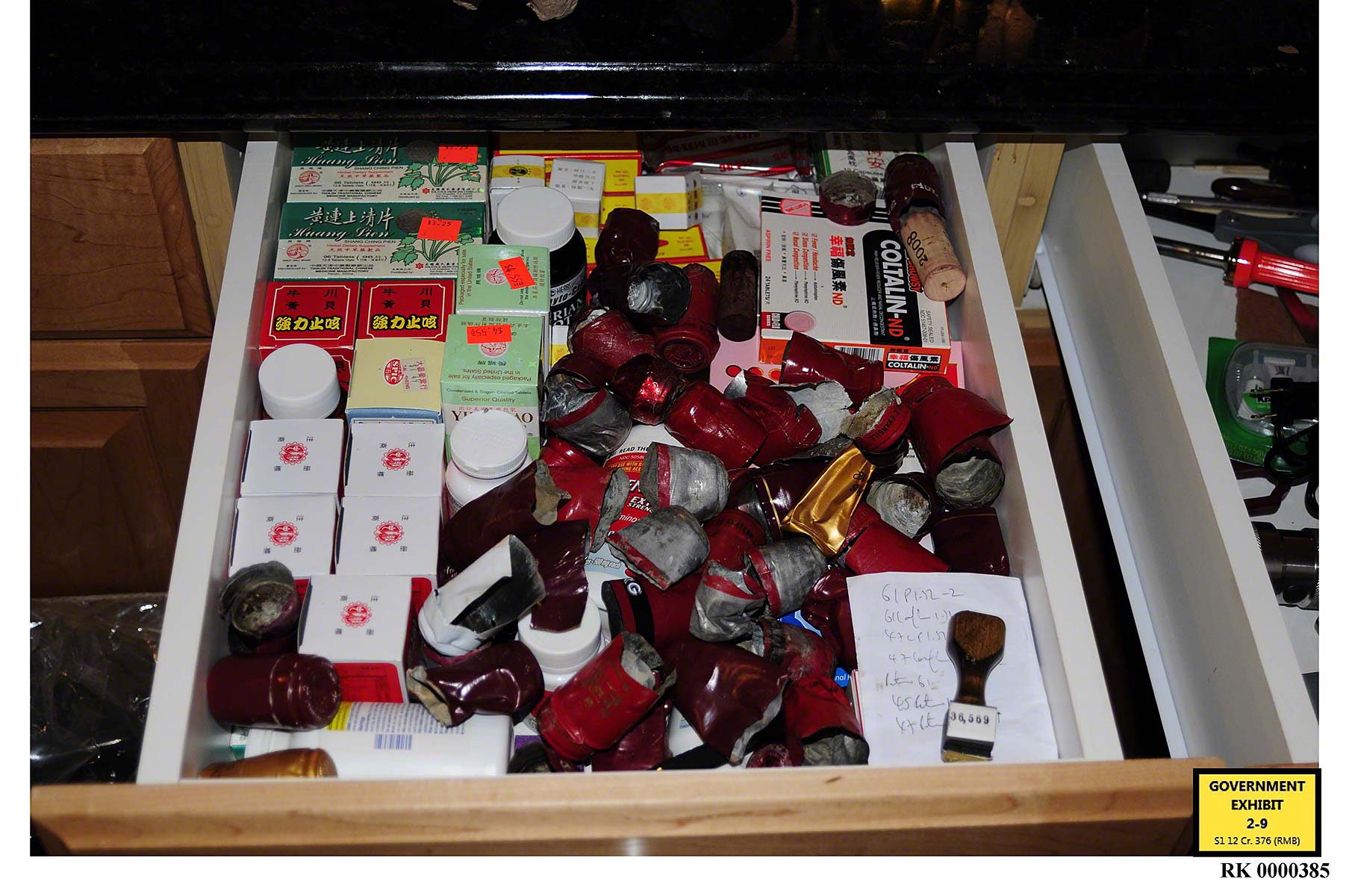The Trial: Part 1
Rudy Kurniawan’s Trial
A Multi-Part Feature on the trial of Rudy Kurniawan, including the transcripts, testimony and evidence that put the largest wine counterfeiter of our time behind bars.
THE TRIAL - PART 1
Rudy Kurniawan’s trial eventually took place from 9th to 16th December 2013. The following is a summary of the trial derived from the trial transcripts and other contemporary reports.
Tyler Coleman (www.drvino.com) described Rudy as a “slight man with a young face”, and Rudy was both slight and young. Far too young, in fact, to have conceivably been collecting wine for “decades”, as Acker Merrall & Condit claimed in its promotional material for The Cellar sale. It was also clear that, although never robustly built, he had lost weight.
Dramatis Personae:
JUDGE:
Hon Richard M Berman, District Judge
DEFENDANT:
Rudy Kurniawan
PROSECUTION:
Preet Bharara: US Attorney for the Southern District of New York
Jason P Hernandez: Assistant US Attorney
Joseph Facciponti: Assistant US Attorney
DEFENCE:
Jerome Mooney: Defence Attorney
Vincent S Verdiramo: Defence Attorney
WITNESSES FOR THE PROSECUTION: (in order of appearance)
Day 2
Barbara Chu, Emigrant Bank Fine Art Finance (formerly Fine Art Capital)
Truly Hardy, Acker Merral & Condit
SA James Wynne, FBI
Day 3
SA James Wynne, FBI (Cont’d)
SA Trenton Schmatz, FBI
Day 4
SA Trenton Schmatz, FBI (Cont’d)
Laurent Ponsot
Christophe Roumier
Aubert de Villaine
Michael Egan
Bill Koch
DAY ONE: MONDAY 9TH DECEMBER
After the jury of 12 plus two alternates was sworn in, the judge gave the jury his opening instructions, including the obligation of the prosecution to prove its case beyond reasonable doubt, the difference between both direct and circumstantial evidence, and what evidence should or should not be accepted, followed by an outline of the structure of a trial.
Award winning wine blogger, author, Tyler Coleman, Ph D, (Dr Vino) likened Jason Hernandez to a Pretty Woman era Richard Gere, an eerily accurate description of a strikingly attractive man. Hernandez opened with the following words:
“This is a case about greed. For years, Rudy Kurniawan… made millions of dollars selling what he claimed were some of the rarest and most expensive wines in the world. He claimed the wines were very old, very special, and made by famous winemakers in France. But those were lies.
“Many of the wines that Kurniawan sold weren’t rare wines from famous French winemakers… but phony knockoffs that Kurniawan made in his own kitchen…. and he sold them for thousands of dollars each by tricking people into thinking the bottles were very rare and very valuable.”
Hernandez stated that Rudy had made millions from this fraud, but had also convinced another company, Fine Art Capital (FAC), to lend him $3m. He lied about how much debt he was in, how much money he spent, and his immigration status in the US. Hernandez then spent some time working through how Rudy had made the fakes, how he had gained the trust of other collectors and developed a reputation for being able to sniff out fakes, and how he sold wines directly to his friends and through auction houses.
Hernandez laid out the two charges against Rudy Count One was committing mail fraud by creating, selling, and trying to sell counterfeit wines. Count Two was committing wire fraud for defrauding FAC when obtaining his $3m loan.
Hernandez ended his opening statement with a plea to the jury to do three things: to listen carefully to the evidence, both as it was presented and in the closing statement when it was summarised; to listen carefully to Judge Berman’s instructions on the law; and finally to “use your common sense. It’s the same common sense that you use in your lives every day as New Yorkers”, in which case, he affirmed that the only possible verdict would be guilty.
Jerome Mooney then opened for the defence. The prosecution clearly had all the looks on their side, but Mooney had a certain bulky gravitas. He thanked the jury for being there, especially at such a frantic pre-Christmas time of year, for such an important role. He noted that most of the witnesses would be called by the government, and most of the evidence would have a government sticker on it, but asked that the jury look at these just as witnesses and evidence, not as government witnesses and government evidence.
Mooney started by addressing Count Two, initially by saying it wasn’t $3m Rudy got; it was $2.5m, because FAC held back $500k for costs and fees. (So, somehow if he lied about $2.5m it was OK?) Mooney claimed that Rudy got the loan “because he had taxes that he needed to pay. Not exactly terribly greedy.” Mooney also claimed that Rudy pledged security to FAC worth $6.8m.
Mooney emphasised Rudy’s Chinese ethnicity and Indonesian nationality, the combination making him “a kind of outsider”. He also brought up the excellent palate that (it is claimed Kurniawan had, which got him introduced to people very into consuming very fine wines, and, Mooney claimed, Rudy started buying them dinner because he wanted to be part of the party.
Mooney asked the jury:
“Try not to reach any quick conclusions, because you need to get the whole big picture of what’s happening before you can really start to put it in the right perspective, before you can see that this poor guy ends up being the one who suddenly gets blamed for everything. When people get embarrassed, when all of this begins to come out in the press, when people start making a big thing about the fact of, oh, look at all these counterfeits. Yes, there are lots and lots of counterfeits. He bought counterfeits, he sold counterfeits. Everybody else bought counterfeits and sold counterfeits. But because he’s not one of the insiders, we’re here. And he’s the one that some of these people are going to want you to believe is responsible for all the awful, horrible things that have happened with regard to the wine market.”
The judge then instructed the jury not to discuss the case with anyone, nor to allow it to be discussed around them, nor to do any research on the matters to be discussed during the trial, and released them for the day.
DAY TWO: TUESDAY 10TH DECEMBER
WITNESS: Barbara Chu, Fine Art Capital
The day started with the government’s first witness, Barbara Chu, a partner of FAC, the company that lent Rudy $3m, now Emigrant Bank Fine Art Finance. Ms Chu is a very experienced banker – having been the national head of commercial mortgages for MetLife, as well as an adjunct professor of real estate finance and capital markets at Columbia Business School.
Today it was Joseph Facciponti (think young George Clooney) taking the lead for the prosecution. He first took Ms Chu through the purpose of the Personal Financial Statement, and of the measures companies such as FAC take to ensure themselves of the value of the collateral. She was the person who underwrote the $3m loan Rudy received, which were ostensibly to bridge payments from his family and to fund a new wine company. Mr Facciponti directed Ms Chu’s attention (and thus that of the jury) to the statements claiming that there were no other loans secured against the property Rudy Kurniawan pledged as collateral, and that RudyKurniawan had no other debts other than a mortgage of $6m and a tax liability of up to $2m. He also agreed to a covenant not to take on any additional indebtedness.
Ms Chu described some of the artworks that had been pledged as collateral, which included works by Andy Warhol, Damien Hirst, John McCracken and Robert Indiana. Ms Chu noted that her company had taken possession of the artworks, and stored them in a specialist warehouse. They do not always take possession of the collateral, but, in this instance, the individual was a foreign national, without a stable and easily documented income source and starting a new business, which increased the risk profile of the loan. [Exhibit 23-1: Security Agreement]
Mr Facciponti pointed out that the money was transferred from New York to California, which Ms Chu confirmed. Those transfers were made in two tranches: one for $1.94m and a second for $500k, both in early 2008.
Mr Facciponti then produced documents in which Kurniawan admitted owing $10.4m to Acker Merrall & Condit (AMC), a New York Auction house, from loans and unpaid interest in 2007 – in other words, before Rudy negotiated the loan from FAC. Ms Chu confirmed that he had not disclosed any of this indebtedness to FAC. He had also not disclosed that he had been ordered deported from the US.
When investigating the loan, Ms Chu called Edward Milstein, the brother of Emigrant’s Chairman Howard Milstein. Eddie Milstein is a large wine collector, and confirmed that Kurniawan was known to be a very large wine collector.
In November 2008, FAC learned that Kurniawan had pledged the same collateral to another party. At that point, FAC declared a default on the loan. The artworks were sold at Christie’s in Spring 2009, and raised enough money to repay the full FAC loan, and some of the AMC money. Ms Chu emphasised that a bank would much rather have the loan repaid than have to sell collateral in such circumstances.
Vincent Verdiramo (think Tony Soprano) took over questioning for the defence. He suggested that Eddie Milstein had been more involved in the loan than initially claimed, and had, in fact, introduced Kurniawan to FAC. Ms Chu said that Mr Milstein informed Rudy of FAC’s services, but that as far as she had been concerned, the contact came when he called and said he was having difficulty with his finance partners, and that was the introduction, not through Eddie Milstein. Mr Milstein merely confirmed he had heard of Rudy as one of the world’s top wine collectors. She got the information that he had sold over $30m of wine through AMC from Google, which she verified with John Kapon of AMC, whom, it turned out on redirect, Rudy suggested she call. (Interesting note here – if MY business were owed $10m and someone rang me about a loan to him, I might be tempted to mention it… Clearly, not something John Kapon felt obliged to mention…) In fact, Verdiramo started the obvious question, but Facciponti objected to it, and it was sustained. Nevertheless, it remains a question to which I think there is a very interesting answer outstanding.
Mr Verdiramo then took Ms Chu through the value of the collateral, and the fees and interest charged on the loan. In total, the loan to value ratio was under 44%, but Ms Chu stressed that this was not at all unusual; if it had been over 50%, that would have been very high. She also noted that the prices in the contemporary fine art market were and remain very volatile.
Mr Verdiramo then presented the credit report of Rudy’s American Express card, which had a limit of $1.8m, and his most recent payment (at the time of the loan) of just under $459k. Mr Verdiramo asked whether this had not made Ms Chu or her credit committee query the $150k pa spend that Rudy claimed. Ms Chu replied that for entrepreneurs, it was often business expenditures. She did accept that she had not asked Rudy what his monthly expenses were on restaurants, hotel, wine, or similar expenditures.
Mr Facciponti then redirected Ms Chu. He asked her to read out the certification that Rudy Kurniawan signed that the information on his loan document was “true, correct and complete”. She confirmed that had she been aware he was an illegal immigrant, that he had millions of dollars in living expenses, or that he owed AMC $10m, FAC would not have made the loan to him.
WITNESS: Truly Hardy, Acker Merral & Condit
The government then called the improbably named Truly Hardy, director of auction operations for AMC. It was surprising to see a witness from AMC, but all was explained when spotted a tracking anklet on him going through security, and discovered he had been arrested for DWI and assaulting an officer on 20 May, in Westchester County, NY, and since he was convicted and it was not a first offence, he had been jailed. Hardy, aged 34 at the time of the trial (and his DWI conviction), had a sort of Owen Wilson look to him, although with a smugness that spoiled things somewhat.
Mr Hardy explained the fine wine auction market, how catalogues are produced for the auctions, who is on the catalogue mailing list, and confirmed that the catalogues are sent via various carriers, including the US Postal Service. He confirmed that Kurniawan was both a buyer and seller at AMC, that both activities had increased over time, and that he had dealt with him personally. He confirmed that Rudy was the principal consignor in the auctions known as “The Cellar or “Cellar I” in January 2006, and “THE Cellar II” in October 2006. Mr Hardy also confirmed that Rudy Kurniawan consigned bottles to an AMC auction in April 2008, including a number of Domaine Ponsot bottles.
Exhibit 15-2, AMC Post-Sale Advice
The government presented as evidence (Exhibits 15-1, 15-2, 15-3, 15-4, and 15-5) the catalogues for these auctions and post-sale advice for the first two auctions. Mr Hardy confirmed that, although Kurniawan was not named as a consignor, this is normal, and he did promote the auction by hosting tastings and dinners prior to the auctions. He testified that Mr Kurniawan’s sale proceeds on THE Cellar I were $7.3m, and on THE Cellar II nearly $16m, but his actual receipts from the combined proceeds were only a few hundred thousand dollars.
Exhibit 15-1, AMC Post-Sale Advice
After the lunch break, the government produced receipts for retail purchases from AMC and THE Cellar by Bill Koch and for THE Cellar II by Don Stott. Mr Hardy agreed that for the 2006 auctions, AMC would have identified the wines sold in that auction with a sticker, noting it was “acquired from a private collection”, with AMC’s name, and the name of the auction. The government then produced Exhibit 5-2, a magnum of 1934 La Tâche from THE Cellar, which sold for $11,000; and Exhibit 5-1, a Methuselah of 1971 Romanée-Conti from THE Cellar II, which sold for $85,000; two other bottles of 1934 La Tâche; two magnums of 1962 Romanée-Conti, from THE Cellar; and a magnum of 1937 Romanée-Conti, also from THE Cellar that sold for $37,000. Mr Facciponti suggested passing this to the jury; Juror #1 suggested that at $40/day it was a risk he didn’t really want to take.
Mr Facciponti then produced three bottles of 1962 Romanée-Conti (Exhibits 6-1, 6-2, and 6-3), which had been part of a six bottle lot sold to Eddie Milstein, but returned by him to AMC over what Truly Hardy referred to as “a question of authenticity”.
Exhibit 4-2, 1934 La Tache
Mr Facciponti then showed Truly Hardy four bottles of 1923 Bonnes-Mares Roumier, part of a six bottle lot that sold for $95,000. He then showed Exhibit 7-5, a bottle of 1929 Bonnes-Mares Roumier with a sticker indicating it came from THE Cellar II, part of a lot of four bottles that sold for $38,000; Exhibit 7-6, a 1934 Bonnes-Mares Roumier from THE Cellar II, which was part of a three bottle lot that sold for $30,000; and Exhibit 7-7, a 1945 Bonnes-Mares Roumier also from THE Cellar II, part of a six-bottle lot that sold for $65,000. Finally, Mr Facciponti produced Exhibit 7-8, a bottle of 1962 Roumier, Musigny from THE Cellar, part of a six-bottle lot that sold for $32,000.
Mr Facciponti then asked Truly Hardy to look at the catalogue from 25th April 2008, where lots 413 through 434 were Domaine Ponsot, which had a collective low estimate of $450k. Mr Hardy confirmed that these lots, and others, had been consigned by Kurniawan, but they were removed from sale because of questions of authenticity, and they were eventually delivered to the FBI. Mr Facciponti then presented Exhibits 8-22 through 8-37, the bottles that were shipped to the FBI.
The government then presented Exhibit 24-2. Truly Hardy confirmed it was a security agreement between Kurniawan and AMC, although he denied having any personal involvement in creating it. This security agreement, dated 15th May 2008, mortgaged a number of items for the benefit of AMC. These items included a number of works of art that were also included in Exhibit 23-1, the FAC collateral agreement. Mr Facciponti then submitted Exhibit 24-3, in which Kurniawan admitted to AMC that another entity had a first priority interest in some or all of the works of art; and Exhibit 24-10, which in July and August 2006 Kurniawan warranted he was the sole owner of an art collection worth $4.5m, and that he would transport this art collection to New York to be stored in a warehouse in AMC’s name as additional security for all advances paid by AMC.
Exhibit 7-1, 1923 Bonnes Mares
Mr Mooney then cross-examined Truly Hardy. He noted the large sums the purchasers were spending on wine – the equivalent of a car for a single bottle of wine at times, and people buying over 500 bottles in a year, just from AMC.
Mr Mooney then highlighted the purchases from Bill Koch, and noted that Mr Koch was no longer an AMC customer; that, in fact, Bill Koch was suing AMC. Nevertheless, he spent $150,000 on nine bottles of wine in one retail transaction. He also spent $1.4m in THE Cellar on 170 bottles, of which 33 were magnums and three larger formats. He also noted that Don Stott bought a number of bottles from THE Cellar II.
Mr Mooney also then noted that Kurniawan had put up for sale 4289 bottles of wine in THE Cellar, and then another nearly 8000 bottles in THE Cellar II, totalling over 12000 bottles. Truly Hardy admitted that AMC owner and president, John Kapon was the person who knew how to put catalogues together, who knew what would catch customers’ eyes (and cause them to bid). Hardy commented that he had never known Rudy not to bring a bottle, which, as Mooney noted, did help his popularity with the people he was dealing with – older, well-established, successful business people. Kurnaiwan’s invitations were, Mooney suggested, implicitly contingent on him bringing wine.
Mooney then remarked on the cut capsules; Hardy did not know which, if any, had been cut prior to the sales. He also commented that there was a leaking capsule on Exhibit 8-22; Hardy admitted that they would not normally sell wines in that condition.
Exhibit 7-7, 1945 Roumier Bonnes Mares
Led by Mooney, Hardy also admitted that was a very talented taster, even though he was a very young man at the time he came onto the wine scene in 2001, and acknowledged he’d have needed to have acquired this knowledge in a very short space of time.
Mooney also led Hardy to comment on the advance on sale being put up by “Bob” and “Roy”, and that for Kurnaiwan, it would be normal to think that the advance was just part of the sale, and that, given that he was still buying, it was normal to think that there would be another sale – and that was in the interests of John Kapon and AMC, because auctions are their business. He discussed the April 2008 auction, where the Ponsot bottles were removed from sale, and the subsequent confession of judgement by Kurniawan that he owed AMC money, relating to wines he had bought but not yet paid for, and advances he received on the sale. However, Mooney emphasised that in December 2007 and January 2008 (i.e. the time at which Rudy was negotiating the FAC loan) there was no indication at AMC that there would be a problem with the April Auction.
Mr Facciponti redirected, asking if at any time it was part of Truly Hardy’s responsibilities to make loans to AMC’s clients, if he was involved in the loan to Kurnaiwan, or if he was made aware of any of the details of those loans. Hardy denied all of it. He also confirmed that if money was advanced to a client, they had to pay that back – and that if wines did not sell at auction, then those clients still had to repay AMC. Hardy also confirmed that he had no basis for knowing what Kurniawan was thinking at any point. Hardy, on further questioning, confirmed that wine was often an investment for many of AMC’s clients, and that the price of rare and fine wines had increased substantially over the decade prior to the trial.
WITNESS: Special Agent James Wynne, FBI
Exhibit 2-7, Empty Bottles On A Treadmill
Jason Hernandez took over questioning, and called Special Agent James Wynne of the FBI, who was a specialist in investigations of art, antique, and collectible theft and fraud. He participated in the execution of the arrest warrant on Kurniawan on 8th March 2012, and identified Rudy in court.
Wynne also confirmed that he received a search warrant for Kurniawan’s home, which they executed that day, looking for evidence of counterfeiting activities, such as corks, capsules, labels, etc., all of which they found. The government submitted as evidence a group of photographs of the home at the time of the arrest and search.
Exhibit 2-8, Drawer Of Front And Back Labels
Hernandez took Wynne through the photos, and Wynne described the counterfeiting assembly line that was, in effect, Kurniawan’s kitchen, including unlabelled bottles of wine on the treadmill, and bottles next to the sink waiting for their turn for completion. Thewindow was covered in silver foil, and there were devices for extracting corks, drawers of front and back labels and of capsules, different glues and waxes, serial number stamps, and bottles everywhere in various stages of completion.
Exhibit 2-9, Stamps, Stamps, Stamps
Wynne then stepped down from the witness box to an evidence table, which held a number of items that had been found in Kurniawan’s house and included in the photos . Hernandez passed to the jury a series of the pre-distressed Nicolas labels, and then a bag of corks and capsules, a bag of stamps (with logos of chateaux), and various other labels, including some from Domaine Ponsot, Domaine Roumier, Chateau Cheval Blanc, Richebourg, Petrus, Lafleur à Pomerol, Chateau Latour and others.
Click Here for Part 2.
